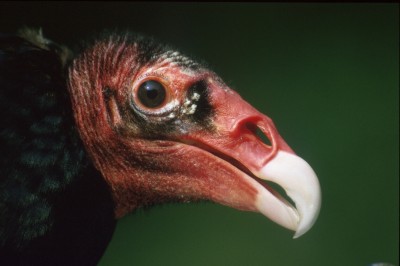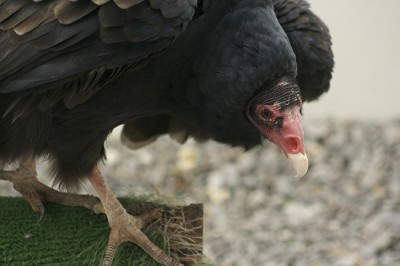Since beginning my environmental education internship at Shaver’s Creek, I have been fortunate to grow acquainted with the fiercely feathered residents of our lively raptor center. The diversity among the species of our raptors here is especially intriguing to me. The physical traits of each species represent adapted mechanisms for stealth, speed, and survival. From the strong grasping abilities of their talons to their intricately layered networks of feathers, it is difficult to look at these magnificent creatures and not be overcome by a sense of wonder. The next time you stop by our raptor center, I would encourage you to ask yourself questions about these birds—why is their coloring is a certain way? Why might they exhibit certain types of behavior? And how have they come to find a home at the raptor center as opposed to living in the wild?
While I feel a deep sense of appreciation for all of our species of raptors here, I have to admit that our turkey vulture holds a very special place in my heart. For those of you unfamiliar with this species, I would be happy to offer up some interesting turkey vulture knowledge. The turkey vulture is a member of Family Cathartidae, along with the California condor and the black vulture. Members of this family of birds can be distinguished by their un-feathered heads and hooked bills that are specially designed for carrion consumption. Turkey vultures in particular can be identified in flight by the two-toned silver and gray underside of their wings. This species commonly holds its wings in an upward V shape and rocks itself from side to side in the air, and actually exhibits very minimal wing flapping motions.
A large part of the reason why I am drawn so much to the turkey vulture is because of the role it plays in its community, a term also known as an “ecological niche.” By feeding on the remains and removing decaying matter found within their communities, turkey vultures are taking on the “dirty” tasks that other species neglect to address. The way I see it, turkey vultures are the unsung heroes of our natural world, diligently consuming unwanted material and contributing to the interconnected processes pertinent to our natural world. To think of these creatures merely as scavengers is to deny them of their true beauty and contributions to the health of our environment.

If you feel at all compelled to form a connection to the natural world, observing some of our raptors here at Shaver’s Creek is a perfect way to begin. In fact, we are now open to the public for the season, seven days a week, from 10:00 a.m.–5:00 p.m.! We would love to have you join us for an unforgettable experience that will bring you one step closer into the infinite beauty of our natural world.
See you soon,
~ Amy “Chickadee” Phillips

